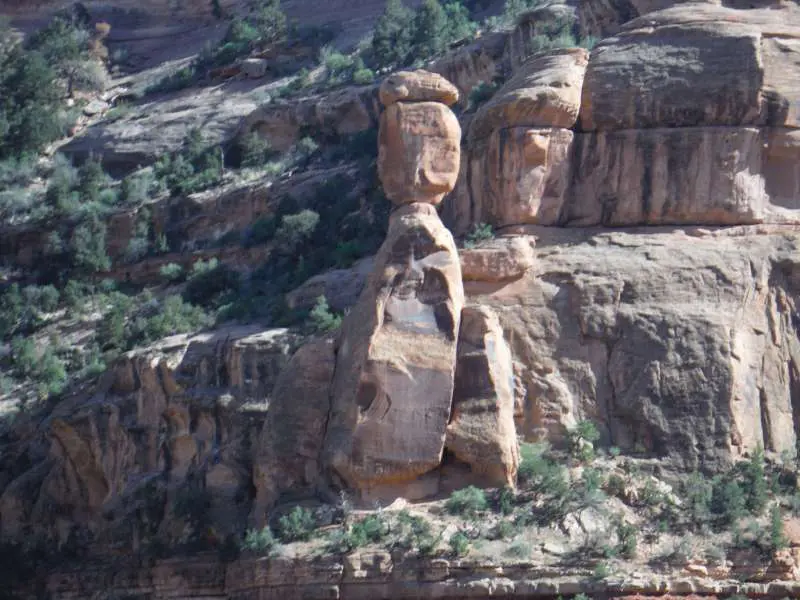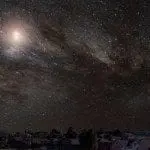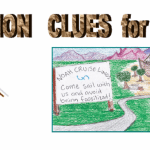
The precariously balanced enormous boulder towered ominously above us. “Careful! Don’t drive too slowly under that rock!” My younger brother anxiously piped up from the back of our suburban, full of friends and family members gathered together for my older brother’s wedding and enjoying the spectacular landscape of the Colorado National Monument in our free time. Those of us who are native to the vast flat-lands of Texas all breathed a little easier when we could appreciate this amazing rock formation from a more distant view.
Last week, we started talking about the geology of Colorado National Monument in western Colorado (read last week’s post here), especially

touching on the canyon and cross-bedding. There are several other especially interesting formations at the Monument, like precariously balanced boulder towers and bent rock layers. Balanced rock formations like the ones seen at the Monument can be quite interesting looking, often just standing up on a thin, high rock pillar based deep inside a canyon. It often makes people wonder why it formed that way and didn’t get swept away with the rest of the rock that was naturally excavated from the canyon by a catastrophic water event.
Often it has a lot to do with just the chemistry of the rock and the way it cracks in organized patterns as the rocks harden and cool. During some of the unstable weather towards the end of and shortly after the global flood (mentioned in the Bible), water and ice would have wedged into these cracks, spreading them farther apart. This would help break away the rocks that used to be right next to the ones we see suspended on high pedestals, leaving the balanced rock by themselves or in clustered groups. The famous “Kissing Couple” formation at the monument is a good example of one of these groups, and got its name because the two rocks towers touch at a couple of points. There is also an interesting “Balanced Rock” formation at “Garden of the Gods” in Colorado Springs (read about that here).

One of the things that fascinated me most about the monument was the tilting of some of rock layer sequences. These tilting were dramatized by the building of the Rocky Mountains in an event called the “Laramide Orogeny” (an “orogeny” is the geologic term for a mountain building event), which probably occurred towards the end of the flood when the waters were draining into the oceans. However, looking at the “Pre-Cambrian” basement rocks bellow (probably made during creation week, about six thousand years ago, based off Biblical genealogies), many of these features were already in place and just dramatized by the building of the mountains. Does that mean that God created this area with small mountains or hills? Possibly – the Bible does say that the flood covered the tallest mountains and high hills at the time (see Genesis 7:19-20).

It’ interesting to see that some of this creation-week (Pre-Cambrian) rock is exposed with flood layers on top of it. Seeing these two together is a somber reminder of both God’s gracious love in creating us as well as His righteous judgment against sin in the flood. One of the most beautiful pictures in the Bible that I know of is that of the Lion and the Lamb – the same Person, Jesus is both the Lion of Judah and the Lamb of God. He is both the ferocious, valiant Lion and the gentle, innocent Lamb of sacrifice. Let these incredible rock formations at Colorado National Monument remind you of that marvelous picture of both God’s righteousness and His grace together.
Copyright Sara J. Bruegel, 2015
References:
Lanny Johnson. Alpha Omega Institute. Private presentation for Bruegel wedding, April 3rd, 2015 in Fruita, Colorado.
Annabelle Foos. Geology of Colorado National Monument. 1999. University of Akron Geology Department. http://www2.nature.nps.gov/geology/education/foos/colm.pdf
D. L. Baars and G. M. Stevenson. Tectonic Evolution of Western Colorado and Eastern Utah. 1981. New Mexico Geological Society https://nmgs.nmt.edu/publications/guidebooks/downloads/32/32_p0105_p0112.pdf
Brian Thomas. Do Sand-Dune Sandstones Disprove Noah’s Flood? . Acts & Facts. 43(9). Institute for Creation Research. http://www.icr.org/article/8231
Steve Austin. Grand Canyon: Monument to Catastrophe, pg. 92-98, 103-104. 1994. Institute for Creation Research
Andrew Snelling. “Mysterious Natural Wonders” . Answers Magazine, Vol. 9 No. 3. July 2014. Answers in Genesis






